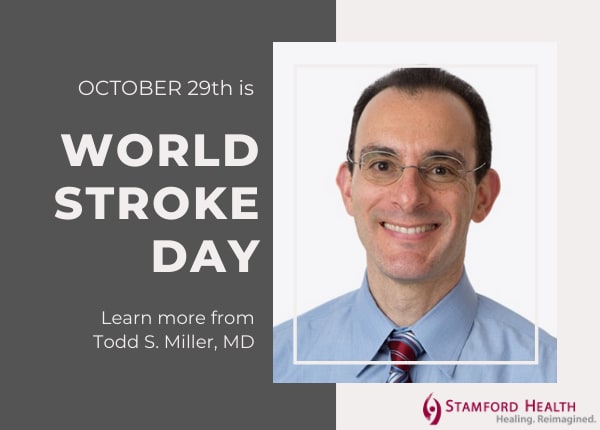By Todd Miller, MD, Neurointerventional Radiology
What are the warning signs of a stroke? Call 911 if:
- Numbness or weakness of the face, arm or leg (commonly on 1 side)
- Confusion, trouble speaking or understanding
- Trouble seeing in one or both eyes
- Difficulty walking, dizziness, loss of balance or coordination
- Severe headache, neck pain or photophobia (light sensitivity) with no known cause
May is National Stroke Awareness Month. National Stroke Awareness Month began in May 1989 and was created to promote public awareness and reduce the incidence of stroke in the United States. While many things have changed in the last 32 years for the better around stroke care, no one at the time of its creation could foresee what we have gone through in the last year alone as a society.
We sat down with Dr. Todd Miller, Director of Neurointerventional Radiology, to talk about the warning signs of stroke, and Stamford Health’s commitment to caring for the community with a dedicated, award-winning stroke care team.
Stamford Health:
Can you quickly reflect back over the past year and share any thoughts surrounding the COVID-19 pandemic as it relates to stroke care?
Dr. Miller:
Pandemic or not, stroke is a critical situation that requires emergency care. Despite the challenges posed by COVID 19, our staff has continued to perform at world class levels and provided top quality care to our patients.
One major challenge we have been seeing nationally is people delaying the absolutely crucial stroke care they need out of fear of coming to the hospital during a pandemic. Delaying emergency care can not only cause missed opportunities, but also dire consequences. Stamford Health puts safety top of mind in every situation—emergent or routine. It is more than safe to come here for your care.
Stamford Health:
Can you walk us through the very first signs of stroke, and what actions to take immediately?
Dr. Miller:
Stroke care begins at home, when the patient’s stroke signs are recognized by a friend or loved one. The single-most important thing is quick action to give them the best chance at a full recovery. This means calling 9-1-1 and getting them to the nearest hospital—not waiting it out to see if any of these symptoms (see next question) improve or pass.
Stamford Health:
It seems wise to post a list of the symptoms somewhere in the home. What are they?
Dr. Miller:
B.E. F.A.S.T. is a simple way to remember the signs of a stroke. It stands for: Balance, Eyes, Face, Arms, Speech, and Time. If you identify any of these sudden symptoms in yourself or someone around you, consider a stroke as the cause and get medical attention immediately.
- Weakness or numbness of the face, arm, or leg, especially on one side.
- Confusion, trouble speaking, or understanding.
- Trouble seeing in one or both eyes.
- Trouble walking, dizziness, loss of balance, or coordination.
- Severe headache with no known cause.
Stamford Health:
Let’s say Stamford Hospital is the nearest location for a patient being rushed to the hospital for stroke. What can they expect from the stroke care team?
Dr. Miller:
The team in the Stamford Health Emergency Department is standing by to help care for patients with stroke symptoms and, of course, any other ailments requiring emergency care. This world-class team has been using the most comprehensive and up-to-date guidelines to keep patients safe despite the COVID-19 threat.
Our stroke neurologists with specialized training in cerebrovascular emergencies (like stroke and aneurism) are available around-the-clock to help diagnose and guide the patient to the correct treatment. This may be immediate use of IV clot-busting drugs, or endovascular thrombectomy (see next question).
Once we quickly treat the patient, the experienced ICU team helps the patient to recover in the Intensive Care Unit. Some of our patients may be transferred to our award winning Van Munching Acute Rehabilitation, which is attached to Stamford Hospital. This allows us to better communicate with the patient as we help guide them and their loved ones through the recovery process before they enter the next chapter of their lives. Of course, our hope is for a good outcome for all of them.
Stamford Health:
What is endovascular thrombectomy and how can it save a patient's life?
Dr. Miller:
Endovascular thrombectomy is the last option for those suffering a major stroke from large vessel occlusion, or blocked blood vessel. It is a minimally invasive surgery that reopens the blocked blood vessel. Without endovascular therapy, these patients will pass away from stroke or be left severely disabled.
To date, over 40% of Stamford Health patients who have had endovascular thrombectomy surgery have left the hospital in good condition. This is at or above national standards. Our average stroke patient at Stamford Health is over 80 years old, far older than the typical patient treated around the world. Older age is a known factor leading to worse outcomes after stroke. Despite that, Stamford Health has a successful track record of treating stroke in the aging population.
We have treated nearly 50 patients with state of the art endovascular cerebral thrombectomy since our cerebrovascular program began at the end of 2018.
Stamford Health:
What, specifically, is Stamford Health recognized for in the world of stroke care?
Dr. Miller:
At Stamford Health we are proud to be accredited at the Gold Medal level by the American Heart Association for our stroke care quality and coordination. We have also been accredited by the Joint Commission on Health Care Quality as a Thrombectomy Capable Center, the only such center in the state of CT.
There is a lot to be proud of with out emergency stroke care at Stamford Hospital. Don’t hesitate to reach out to one of stroke care professionals if you or a loved one is suffering from new stroke symptoms. We are here to help.
Featured Expert/ Author








